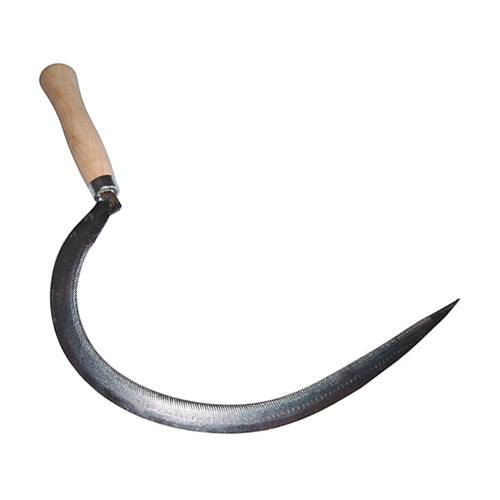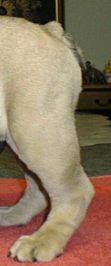

 “Sickle hocks.” Good thing? Bad thing? Does your dog have them? Does it matter if your dog has them and is, “just a pet?” Yes, it matters.
“Sickle hocks.” Good thing? Bad thing? Does your dog have them? Does it matter if your dog has them and is, “just a pet?” Yes, it matters.
The descriptive term, “sickle hocks” comes from the farm tool seen at the left, and if you study the other pictures, you’ll see why.
How can you tell if your dog has sickle hocks?
A dog with sickle hocks usually stands with his rear pasterns slightly forward in order to support weak hindquarters. When trotting, his top line will bob up and down which results in wasted energy. Instead of moving forward with power, the dog’s energy goes “up and down.”
What causes sickle hocks? Usually, a more acute angulation of the hock joint than is normal for the breed. The hock angle doesn’t change while the dog’s leg is moving, and so from a side view, the motion of the dog’s rear legs moving is not unlike the motion of someone using a sickle.
Why does this matter? Let us count the ways:
A dog with sickle hocks has a poorly synchronized gait which destroys the dog’s efficiency. If your dog is “just a pet,” this will impact the pleasure s/he has going for long walks and playing fetch.
A dog with sickle hocks will have no follow-through (remember when we talked about a golf swing’s “follow through a couple of weeks ago?) With no follow through, the dog’s drive will be reduced. She’ll spend more energy bobbing up and down than going after the ball you just threw. She’ll tired more easily from activities she’d love to do for a longer time.
It matters because the dog with over-angulation resulting in sickle hocks can’t extend his hocks properly while he trots, and that will restrict the driving force of his hind legs, and therefore reduce the power in his rear.
Does this matter if you don’t have a show dog? Well, you tell us. Do you like to take long walks with your dog? Does your dog love playing fetch? Running agility? Tracking for fun? Does your dog help you “work” by giving the squirrels in the yard “what for?”
Sickle hocks limit what your dog can do with you comfortably, and without pain. More importantly, a sound dog is less likely to “break down” from injury; she’ll experience less fatigue, be able to take those long walks with you, and show greater efficiency in work (even if it’s only to help you corral those squirrels).
And mostly importantly of all, a sound dog stays healthier and more active throughout her life. This is why we at National Purebred Dog Day® emphasize the importance of getting a dog from an heritage breeder invested in their breed, one who knows the importance of breeding sound dogs to create sound puppies. So what do you do if your dog does have sickle hocks?
You continue to love your dog. You enjoy him or her, feed them treats, and spoil the dog rotten, What you don’t do is breed them. What you shouldn’t do is ask of them something beyond their physical ability. When it comes to endurance and efficient movement, recognize your dog’s limitations, and do what he or she can do comfortably.

Can a puppy out grow sickle hocks?
Probably not, Karen.
Love this article!!!!! Educate!!
This is great information and the finishing comments are very kind and loving.
Can this condition hide itself and then become apparent later in life?
We’re not medical experts, Heather, and for learned advice, always consult a veterinarian. We can, however, offer an uneducated opinion, and the short answer is “doubtful.” True sickle hocks that are the result of structural shortcomings with which the dog is born are evident early on. If a dog suddenly manifests sickle hocks in his later years, it’s likely the result of an injury. The dog might have a canine form of arthritis called Osteoarthritis of the hock joint, a degenerative joint disease common in older dogs. We hope this helps, but especially, we invite readers to share their own answers to your question.